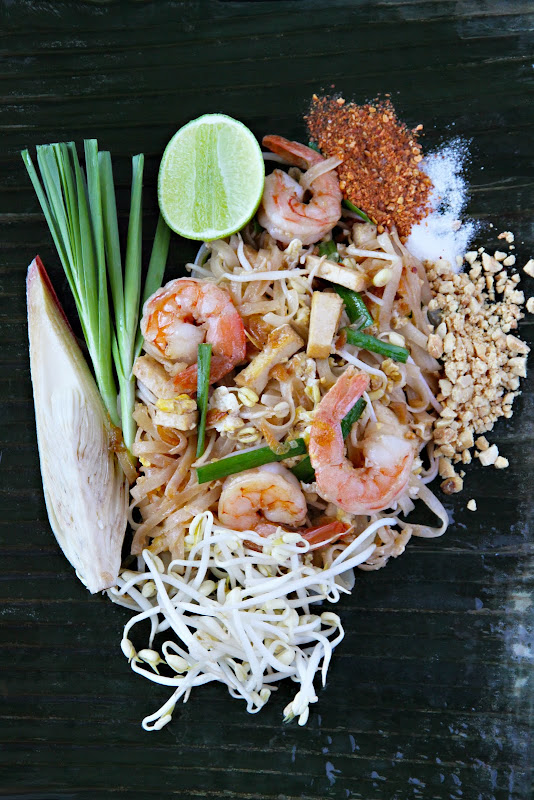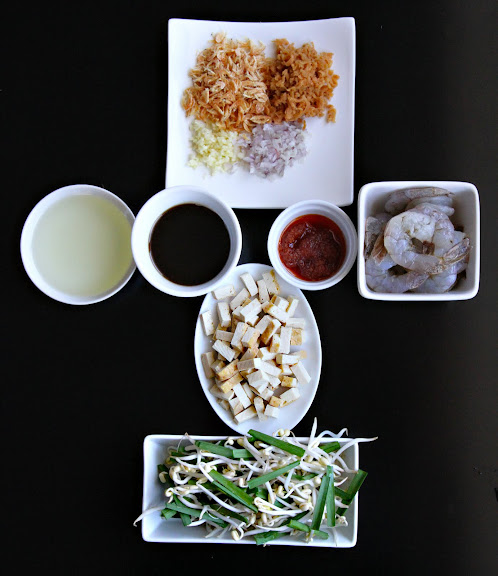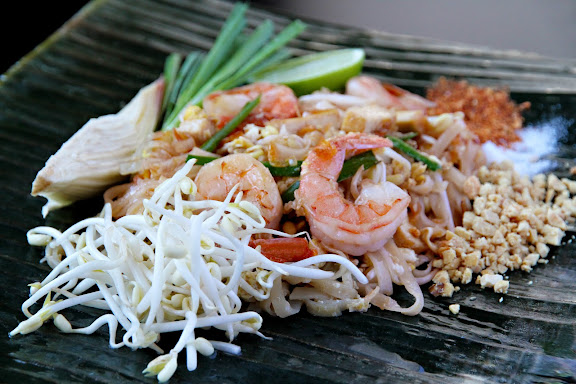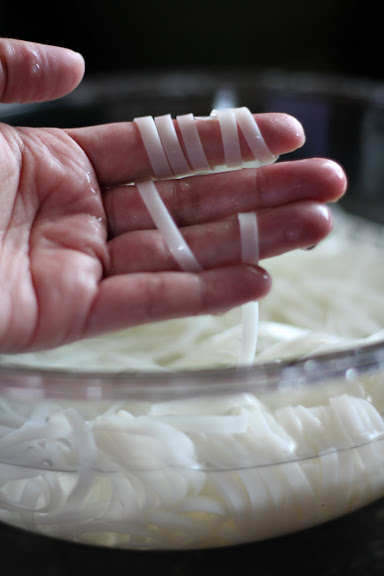
In order for this final post in the Pad Thai recipe series to make sense (or become clear as to why it is sketchy or seems to leave out important details), it is assumed that all of the earlier posts have been read in their entirety. Therefore, if you have not done so, may I please invite you to visit the following posts before continuing?
Pad Thai Recipe Part One: The Pan – In this post, I discuss the importance of choosing the right type and size of Pad Thai pan to create the closest replica of what respectable Pad Thai stalls in Bangkok produce.
Pad Thai Recipe Part Two: The Noodles – In this post, I discuss the right type and size of noodles to use in this dish and how to prepare them.
Pad Thai Recipe Part Three: The Notable Ingredients – In this post, I introduce to you some of the ingredients and garnishes routinely used in street Pad Thai in Bangkok but often omitted at Thai restaurants overseas.
Pad Thai Recipe Part Four: Pad Thai Sauce and Seasonings – In this post, I share my favorite Pad Thai sauce recipe and discuss the seasoning of Pad Thai on and off the stove.
Most of what I believe to be the key issues have already been discussed in the earlier posts, so there’s not much left to talk about. It’s all about action from this point on. This is the most crucial part where additional information is not needed nearly as much as hands-on experience.
The immediate goal of this series is to facilitate you in creating the version of Pad Thai which I like, using the ingredients and method commonly employed by street vendors in Bangkok, my hometown. But that’s just to get you started; it’s not the ultimate goal. Eventually, you will want to get to a place where you can move the noodles around in the pan with the spatulas and know just how much longer it will take for them to cook, how often to stir them, whether the heat is too low or the evaporation rate is too high, how to season it, etc.
The ultimate goal is for you to know how to make Pad Thai which is different from how to follow a Pad Thai recipe. In other words, I’ve put you through five long posts so that eventually you won’t need them anymore.
I hope this entire series has been helpful in keeping as many preventable mistakes as possible from happening. But when it comes to a dish like this where — I think — the mastery of technique is more important than the procurement of ingredients (which, of course, is not to say that ingredients aren’t important), there’s only so much written — or even visual — instructions can do for you.

However, some of these tips may help you:
- I can’t stress this enough: prepare your ingredients beforehand and have them nearby. Timing is of utmost importance. Making Pad Thai isn’t hard; it does, however, require a fairly high level of concentration.
- You must use oil — this much oil. A pan lightly coated with nonstick spray is cute to look at, but no good Pad Thai has ever come out of it. Using more oil than necessary is not a good idea either; it will only result in oily Pad Thai.
- Do not use a pan smaller than 14 inches for this recipe. If you halve this recipe, you can use a 12-inch pan, but nothing smaller than that. I personally prefer making my Pad Thai in a large cast iron pan. Many have written me saying that, due to lack of storage space, they cannot and will not buy a 17-inch cast iron pan for the sole purpose of making Pad Thai. That is understandable. Therefore, I have demonstrated how to make the dish in a regular nonstick 14-inch pan.
- You can halve the recipe, but I would not double it. I won’t even make more than this at a time in my 17-inch cast iron pan. In fact, we’re already pushing it by making this much Pad Thai in a 14-inch pan.
- You can use a large round-bottomed wok, but, as you will see, making Pad Thai this way is easier to do in a flat pan.
- The material of which your pan is made, the thickness of its bottom, the height of its rim, and its size all directly affect the rate at which the sauce gets absorbed into the noodles as well as how long it takes for the noodles to be ready. Add the level of heat and its source (flame versus electric coil) to the mix and we have endless possibilities of what can happen.
- As you can see from the previous point, it’s utterly impractical — and I think quite naïve — for a recipe to be telling you how long you should cook the noodles, how much moisture is needed, what to add to the pan after how many minutes have passed, etc. In an ideal world, each and every one of all the various factors at work in the development of a recipe will apply in every single replication of the same recipe, yielding the exact same result every single time. In the real world, that is hardly the case. Instinct and common sense come in handy here.
- Make sure the noodles are adequately hydrated. As long as they pass the twirl-around-the-fingers test, they’re fine. Some have asked whether the noodles should be blanched before going into the pan, and my answer is that I find it to be an unnecessary step which carries more risk (of clumped-up or soggy noodles) than reward (shorter soaking time). But adequate soaking is all it takes to eliminate this step which no street Pad Thai vendors take, based on what I’ve seen. And I think letting the noodles sit in water undisturbed for roughly half an hour can’t be more complicated than going through the trouble of boiling up a pot of water and synchronizing the blanching and the frying, etc. In short, I see absolutely no point in blanching the noodles.
- Evaporation is key. Use your instinct to judge whether the heat is too low or high for your situation. At no point should the noodles sit in a pool of moisture quietly; that invariably leads to soggy noodles. Ideally, we want the noodles to be softened with just the sauce and the heat, and we want the sauce to be fully absorbed into the noodles quite quickly. But if the noodles are still undercooked after the sauce has been fully absorbed, a bit of plain water should be added to the pan to help the noodles soften up. Don’t add more sauce; you will only over-season the dish.
- I use shrimp here for that is the most common meat used in Thailand. I have never had Pad Thai with chicken, pork, beef, etc., until I came to the United States. There’s a shop in Bang Pho area close to my grandparents’ house that makes their famous Pad Thai with pork liver (which I adore), but that’s an anomaly. If you like your Pad Thai with chicken, pork, or beef, be sure to slice the meat thinly so it cooks at the same rate as whole shrimp.

_________________________________________
PRODUCTS THAT HELP YOU CREATE THIS RECIPE
- ⅓ cup (83mL) plain vegetable oil
- 4 ounces (113g) 2-3 millimeters wide dried rice noodles, following the instructions on how to prepare dried rice noodles for Pad Thai
- ⅔ cup (~166mL) prepared Pad Thai sauce
- 1 tablespoon (14mL) shrimp paste in oil (มันกุ้งเสวย), as mentioned in my post on Pad Thai ingredients, optional
- 2 large cloves (8g) garlic, peeled and finely chopped
- 1 medium shallot (18g), peeled and finely chopped
- ¼ cup (24g) finely-chopped preserved radishes
- ¼ cup (8g) shell-on small dried shrimp (the kind specified in my post on Pad Thai ingredients
- ¾ cup (100g) the firmest tofu you can find
- 220g (1/2 lb) large (31-35/lb) shrimp, peeled and deveined
- 2 large eggs, cracked into a bowl
- 6-7 stalks of Chinese chives
- 2 cups (110g) bean sprouts
- Garnishes and extras:
- Sugar, dried red pepper flakes, fish sauce, and fresh limes
- Chopped dry-roasted peanuts
- Extra bean sprouts, soaked in acidulated water (to keep them fresh and crunchy)
- Chinese chive stalks
- Banana blossom, trimmed according to the instructions in my post on Pad Thai ingredients
- Cut the chive blades into 1-inch pieces; reserve the bottom parts of the stalks to eat with the finished dish.
- Set over medium-high heat a flat pan (preferably well-seasoned cast iron pan or nonstick paella pan), no smaller than 14 inches wide. Add half of the vegetable oil to the pan when it’s hot.
- Immediately add the noodles to the hot oil, followed by the sauce (if you want to add the shrimp in oil to the dish, add it to the pan now along with the sauce); stir constantly (this is much easier done with two spatulas). Keep the noodles moving all the time.
- After about 30-40 seconds, with the tips of your spatulas, you should be able to feel that the noodles have softened up considerably. At this point, push them to one side and add the remaining vegetable oil to the empty side of the pan.
- Add the garlic, shallot, preserved radishes, dried shrimp, tofu, and shrimp.
- We have now reached the critical point of the process. The task before you is do whatever you can to: 1. keep the noodles moving almost constantly to keep them from burning or forming excessive crust at the bottom, 2. get the shrimp to cook about ½ way through, and 3. keep all the small bits of stuff in the pan from burning (those around the perimeter tend to burn first).
- Once the shrimp is turning a bit opaque on both sides and all the small bits are getting brown, make a well in the middle into which you add the eggs.
- Break and scramble the eggs with the tip of your spatulas; let them cook undisturbed on one side before flipping and breaking them into smaller pieces, keeping an eye on the other members of the pan the whole time, especially the noodles.
- By the time the eggs are cooked: 1. the shrimp should be fully, but not overly, cooked, 2. the noodles are soft and chewy, 3. the sauce has been entirely absorbed into the noodles, and the little bits have crisped up and caramelized.
- Turn off the heat immediately.
- Add two handfuls of chive-bean sprout mixture to the pan and give it all a quick but gentle stir. We want to wilt the bean sprouts and chives while getting all the little bits thoroughly interspersed into the noodles. Your Pad Thai is now done. You can serve it immediately, or you can let it cool for 8-10 minutes in the pan (which, in my opinion, is when Pad Thai is at its best).
- Top with 2-3 tablespoons of chopped peanuts per serving. Place a wedge of banana blossom and chive stalks on the side. Season to taste off the pan with extra fish sauce, lime juice, sugar, and dried red pepper flakes as necessary.








87 Responses to Pad Thai Recipe (ผัดไทย) – Part Five: Making Pad Thai